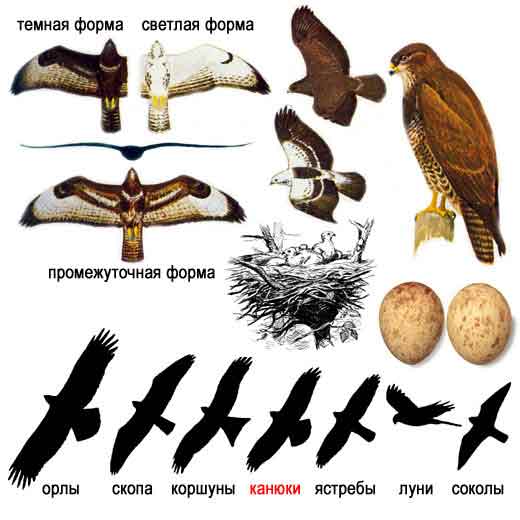See list of all Buteos - Buzzards
here
Common
Buzzard,
No: Musvåk, Buteo buteo 
 Photo: ©
Arthur Grosset.
Photo: ©
Arthur Grosset.
The Common Buzzard is found throughout most of Europe and northern
Asia into Japan. While it is resident all year round in
central and western Europe as well as Japan, it is
migratory elsewhere with the Asian populations wintering in
eastern and
southern Africa, China and Indo-China. It is one of the most common
raptors in these areas and is generally easy to see
whether perched or flying.
 Photo: ©
Arthur Grosset.
Photo: ©
Arthur Grosset.
It thrives in a variety of habitats but requires some sort of tree
cover for its nest. It feeds on small mammals such as voles
and rabbits, nestlings and fledglings, lizards, etc., and is also
a scavenger frequently to be seen at road-kills.
 Photo: ©
Dennis Olsen
Photo: ©
Dennis Olsen
It can find its prey by gliding or soaring but more commonly catches
its prey dropping down from a perch on a branch,
rock or fence-post. It has very variable plumage but almost always
shows a pale band across the lower chest.
In flight it shows broad wings and a short tail often fanned out.
 Text and Photo:
© Arthur Grosset.
Text and Photo:
© Arthur Grosset.

 Common
buzzard - overview and Courtship flight,
chicks in nest being fed, competing with each other
Common
buzzard - overview and Courtship flight,
chicks in nest being fed, competing with each other
BBC Natural History Unit
http://www.arkive.org/common-buzzard/buteo-buteo/video-00.html
and video-09a.html
Rough-legged
Hawk,
No: Fjellvåk, Buteo lagopus
 Mountain
Buzzard, No: Flekkvåk, Buteo lagopus
© www.ecosystema.ru/
Mountain
Buzzard, No: Flekkvåk, Buteo lagopus
© www.ecosystema.ru/
The Rough-legged Buzzard, Buteo lagopus, called
the Rough-legged Hawk in North America, is a medium-large bird
of prey. It is found in Arctic and Subarctic regions of North
America and Eurasia during the breeding season and
migrates south for the winter.
The tail is white with a dark terminal band. The feet are
feathered.
The species exhibits a wide variety of plumage patterns including
light and dark morphs.
Nests are typically located on cliffs, bluffs or in trees.
Clutch sizes are variable with food availability but 3–5
eggs are usually laid. These hawks hunt over open land, feeding
primarily on small mammals. Along with the Kestrels, Kites
and Osprey, this is one of the few large birds of prey to
hover regularly.
|
 Rough-legged
Hawk
Rough-legged
Hawk
Photo: Walter Siegmund, http://en.wikipedia.org/wiki/File:Buteo_lagopus_29283.JPG
This fairly large raptorial species is 48–60 cm with
an average wingspan of 120–153 cm . Individuals can weigh
from 600 to 1,800 g with females typically being larger and
heavier than males. The plumage is predominantly
brown in colour and often shows a high degree of speckling.
A wide variety of plumage patterns are exhibited in
light vs. dark morphs, males vs. females and adults vs. juveniles.
Extensive field experience is required to
distinguish between certain plumage variations. Compared to
its more common cousins, the Common Buzzard
and the Red-tailed Hawk, it is
slightly larger, though may be outweighed by the latter. |
The Rough-legged Hawk breeds in tundra and taiga habitats
of North America and Eurasia between the latitudes
of 61 and 76° N. Rough-legged Hawks occurring in North America
migrate to the central United States for the
winter, while Eurasian individuals migrate to southern Europe
and Asia. During these winter months, from
November to March, preferred habitats include marshes, prairies
and agricultural regions where rodent prey
is most abundant.
 Rough-legged
Hawk (Buteo lagopus) - Carolina Raptor Center at Huntersville,
North Carolina
Rough-legged
Hawk (Buteo lagopus) - Carolina Raptor Center at Huntersville,
North Carolina
Photo:
DickDaniels, http://en.wikipedia.org/wiki/File:Rough-legged_Hawk_RWD1.jpg |
Breeding sites are usually located in areas with plenty of unforested,
open ground. Depending on snow conditions, migrants arrive at
breeding grounds during April and May. Home ranges vary with
food supply but are commonly reported to be 10–15 square
kilometers during the winter, but little is known about home
ranges during the breeding season. Although frequently attacked
by other bird species such as Gryfalcons and Skuas, the Rough-legged
Buzzard is not strongly territorial.
|
Mountain
Buzzard, No: Flekkvåk, Buteo oreophilus
The Mountain Buzzard, Buteo oreophilus is a bird
of prey that lives in montane forests in East Africa (Ethiopia
, Kenya, Tanzania, Uganda, Rwanda, Burundi and extreme eastern
DR Congo) and forests and plantations in
South Africa. The latter population is sometimes considered
a separate species, the Forest Buzzard, Buteo trizonatus.
Other Names: African Buzzard, African Mountain Buzzard, Buteo
tachardus, Woodland Buzzard.
There are two recognized subspecies:
Buteo oreophilus oreophilus
Buteo oreophilus trizonatus
 A
Mountain Buzzard in Ethiopia
A
Mountain Buzzard in Ethiopia
Photo: Alastair Rae, http://en.wikipedia.org/wiki/File:Buteo_oreophilus_-Ethiopia-8.jpg |
At 45–50 cm, it is smaller than the Steppe Buzzard and
darker brown, with less rufous above.
The Mountain Buzzard is partial migrant, with juveniles dispersing
from breeding areas
It occurs in patches of hilly and montane forests, including
exotic plantations. In Malawi, it is confined to montane
rainforest, and it does not feed in open grassland outside
the forest. Spends most of its time perched,
but may also soar overhead. Usually seen singly or in pairs.
The bird feeds on small mammals, reptiles, and insects.
which it captures by gliding down from an exposed perch.
Has been recorded hunting bats at caves in Uganda. Also rarely
hunts over grasslands near forests.
When breeding it bulds a stick nest placed in the upper fork
of a large forest tree. more....
Source:
Global Raptor Information Network. 2012. Species account:
Mountain Buzzard Buteo oreophilus.
Downloaded from http://www.globalraptors.org on 15 Feb. 2012
|
Now, if you think you know all abut the Buzzards, Buteo,
Well, tere are approximately 172 species in this genus. See list
of the real buteos here.:
See
list of all Buteos - Buzzards here
500 other birds - click here
|

















